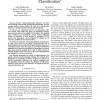Free Online Productivity Tools
i2Speak
i2Symbol
i2OCR
iTex2Img
iWeb2Print
iWeb2Shot
i2Type
iPdf2Split
iPdf2Merge
i2Bopomofo
i2Arabic
i2Style
i2Image
i2PDF
iLatex2Rtf
Sci2ools
SIGMETRICS
2008
ACM
2008
ACM
Layered interval codes for tcam-based classification
Ternary content-addressable memories (TCAMs) are increasingly used for high-speed packet classification. TCAMs compare packet headers against all rules in a classification database in parallel and thus provide high throughput. TCAMs are not well-suited, however, for representing rules that contain range fields and prior art algorithms typically represent each such rule by multiple TCAM entries. The resulting range expansion can dramatically reduce TCAM utilization because it introduces a large number of redundant TCAM entries. This redundancy can be mitigated by making use of extra bits, available in each TCAM entry. We present a scheme for constructing efficient representations of range rules, based on the simple observation that sets of disjoint ranges may be encoded much more efficiently than sets of overlapping ranges. Since the ranges in real-world classification databases are, in general, non-disjoint, the algorithms we present split ranges between multiple layers each of which c...
| Added | 15 Dec 2010 |
| Updated | 15 Dec 2010 |
| Type | Journal |
| Year | 2008 |
| Where | SIGMETRICS |
| Authors | Anat Bremler-Barr, David Hay, Danny Hendler, Boris Farber |
Comments (0)

